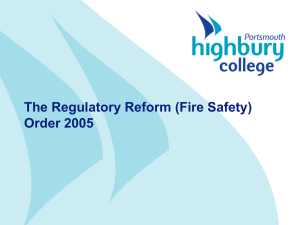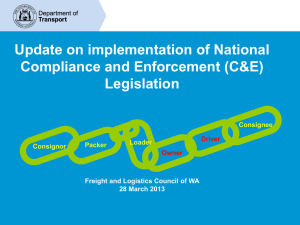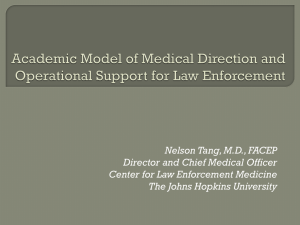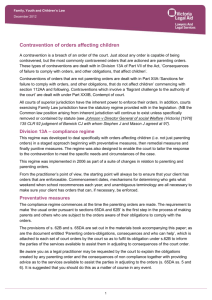Enforcing Regulatory Schemes
advertisement
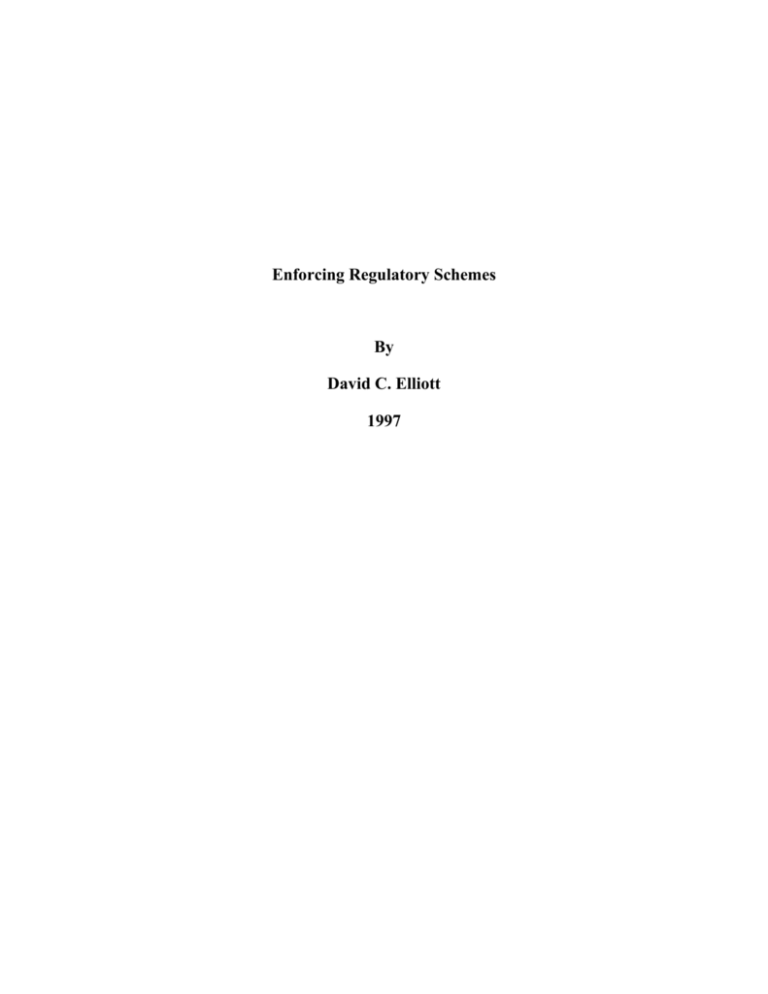
Enforcing Regulatory Schemes By David C. Elliott 1997 Contents Introduction Ancient traditions A transformation in enforcement policies Why enforcement policies have changed Range of compliance mechanisms Monitoring regulatory outcomes Summing Up Enforcing Regulatory Schemes Introduction [This one-of-a-series of commentaries on Regulatory Reformation review schemes for enforcing regulations.] Regulation today is pervasive. Hardly any activity is untouched by government regulation. Governments throughout Canada face a regulatory challenge. Poor regulatory practices cause public cynicism, fail to meet policy objectives, result in non-compliance, impose unnecessary bureaucratic requirements, and impose unnecessary costs for both the regulated and the regulator. Good regulations takes time, though, and usually some form of consultation aimed at reaching consensus. All three of these elements are in short supply. As a 1992 Canadian House of Commons Finance Committee describe it, regulation is not necessarily bad, but too often we have bad regulation. In this series of commentaries on Regulatory Reformation, "regulation" is used in the broad sense of a law directing or prohibiting conduct or action whether the law be in the form of an Act, regulation, bylaw, or rule. Other commentaries in the Regulatory Reformation series are Designing Effective Regulations Assessing the Need for Regulation Preparing Drafting Instructions for Legislation The commentaries are available, free of charge, from: David C Elliott Legislative Drafting Services Email: words@davidelliott.ca Ancient traditions The earliest written law from England contained penalties for anti-social behaviour. The sixth-century laws of King Ethelberht prescribed: 33. For seizing a man by the hair, 50 sceattas shall be paid as compensation. 34. If a bone is laid bare, 3 shillings shall be paid as compensation. 35. If a bone is damaged, 4 shillings shall be paid as compensation. 36. If the outer covering of the skull is broken, 10 shillings shall be paid as compensation. 37. If both are broken, 20 shillings shall be paid as compensation. Our modern-day equivalent has seen the intervention of the state: Any person who contravenes a provision of this Act is guilty of an offence and liable to a fine of not more than $5000. A transformation in enforcement policies Regulatory schemes have tended to evolve from exact prescriptions of behaviour, a contravention of which made the transgressor liable to a fine, to a more open ended prescription of rules enforced by government appointed inspectors, enforcement schemes which look to methods of rewarding or providing incentives for compliance, and self regulation with sectorally administered enforcement and privatization of inspectorate functions. Some legislation now makes it easy to admit guilt, and pay a fine or correct the error through a ticketing process. Why enforcement policies have changed Enforcement schemes have changed from pure prosecution to various models of positive compliance for many reasons: pure policing and prosecution is costly, time consuming, and often ineffective; 2 older enforcement methods treat a symptom but not the underlying problem; enforcement relies on government employees and not on the buy-in of effective standards by those affected by them; some precise regulations quickly become out-dated as technologies and practices change and lack of enforcement causes disrespect for the rules; penalties are applied only if an inspector discovers the contravention. Even with good resources and unscheduled inspections, contravention's are not all caught. The quasi-criminal nature of some enforcement processes makes success difficult, developing a built-in incentive to cover up contraventions; regulations tend to be devised without adequate involvement of those affected by them. The regulations often do not grow out of an awareness of industry or its problems, but from a conceptual diagnosis of problems by others outside the industry; even if industry is consulted, there is often no role for members of the industry to participate in developing or updating regulations. If participation is invited, industry representatives are often constrained by the lack of definition of their role and mystified by the process of regulation-making; the role of inspectors is often ambiguous. Because of the nature of many regulations, inspectors tend to encounter trivial breaches. Inspectors may ignore these breaches or nitpick. The difficulty of having penalties effectively imposed for serious breaches encourages inspectors to use warnings, suggestions and discussion to achieve good practices rather than to prosecute. These ancillary processes of "enforcement" were not reflected in the old enforcement model; the old enforcement model removes responsibility for compliance and interpretation from the owners, managers, and those directly affected by the regulation. The inspector is required to identify a standard and to suggest what must be done to comply with it; when penalties are invoked, the old model assumes that policing is essential and that an inspector knows best. This assumption is challenged by modern thinking; even when the old model of regulation is changed, there is often inadequate training and information available to equip inspectors for their new role; fixed penalties become out-dated and are often seen as little more than a licence fee for the contravention, if the regulation is enforced at all. 3 Range of compliance mechanisms The newer concept of enforcing regulations is reflected in the terminology – compliance rather than enforcement. The modern approach often involves those affected by the regulatory scheme helping to design it. This involvement often results in higher compliance rates because: the standards are known and understood, the technical quality of the regulation is usually better because of the participation of those to be regulated, those to be regulated may undertake some self-regulation, compliance incentives are industry-specific and so likely to be more effective, and systems of regular review and revision can keep the regulation up-to-date. Modern regulatory schemes typically offer a phased approach to ensuring efficient, effective, and fair compliance. Those involved in creating regulatory compliance schemes should consider the following: strong promotional, informational, educational, and advisory support for the regulatory scheme [Those who are well-intentioned need only good information to comply with the law. Often good information is the best and least expensive compliance mechanism.] advisory warnings [General or specific notices sent out to the regulated sector warn them of actual or potential contravention’s.] mediation and facilitation [If the issue in dispute is between two or more persons, some form of facilitated or mediated discussion may resolve the issue. For example, employment standards officers are given a strong settlement-oriented mandate to resolve disputes between employees and their employers.] notices [Typically, the notice directs that improvements or corrections be made within a specified time in order to avoid sanctions. The notice may be no more than a 4 warning or it may have consequences for non-compliance. See also corrective/remedial orders below.] publication of notices [Sometimes public pressure can be effective. The regulatory scheme may authorize publication of real or potential contraventions of the regulation. Publicity could be used at various points on the continuum of compliance mechanisms.] compliance agreements [If a problem is identified and recognized, negotiation can result in an agreement to correct the problem by taking specific action within a specified time. Failure to follow the compliance agreement may be a contravention of the regulation. Financial incentives for compliance and disincentives for non-compliance may also be part of the agreement.] ticketing and voluntary payment [The concept of giving a violation ticket with an option for voluntary payment of the fine is now used for many federal, provincial and bylaw offences.] corrective/remedial orders [These orders direct that some action be taken or stopped. They may or may not demand some form of compensation be paid.] self-activating arbitration processes [A form of compulsory and binding arbitration can be imposed through a regulatory scheme if a dispute involves two or more people, and no government intervention is necessary (e.g. Through an inspector's remedial/corrective order). This is a well established response in labour relations statutes but its use is growing in other areas with the emergence of modern Arbitration Acts.] creation of statutory claims for compensation [Examples of statutory claims for compensation in the courts or through specially created tribunals include workers' compensation claims, employment standards claims, claims resulting from contraventions of human rights and landlord and tenant legislation, and compensation for victims of crime.] 5 creation of offences, linked with additional remedies [In addition to other compliance strategies, regulatory schemes usually include provision for prosecution. Sometimes the court is provided with additional powers, not only to impose a fine but also to remedy the underlying problem (e.g., order payment of wages or correcting contraventions of an Act). Offences may also be designed to go behind the corporate entity and make directors and senior officers of the corporation personally liable for corporate offences.] prohibition / stop work orders [As the gravity of the contravention increases, so does the significance of orders that can be issued, usually with court review or other form of appeal.] seizure of equipment or product [After seizure, the law may provide for the equipment or product to be destroyed, returned, or otherwise used, once it is no longer needed for evidentiary purposes.] court orders [These are often made available through an expedited process and provide for injunctive or directory orders.] probation/trusteeship [When assets may disappear, probationary or trusteeship orders can protect the assets for creditors or others entitled to compensation.] limitation, suspension, revocation of licences [Licensing systems are an effective means of controlling conduct. They can be used to improve conduct (through conditions attached to the licence) or permit a swift response to bad practice through suspension or revocation of licences.] imprisonment [Imprisonment is used these days in legislation as an indication of the seriousness with which the offence is regarded by society.] Those designing regulatory scheme should work out a compliance strategy in the context of an approach that uses low cost, least adversarial, and voluntary mechanisms first. 6 uses adjudicative processes as a last resort, and allows options to loop back to low cost, least adversarial and voluntary mechanisms at appropriate points in the process. Processes for review and appeal are built into these compliance mechanisms as required. The more intrusive the compliance mechanism, the greater the need for a fair process as a check on abuse or misuse of executive power. Monitoring regulatory outcomes Over-control and under-control of regulatory schemes are both problems. Over-control wastes resources and frustrates he regulated. Under-control results in failed and unenforced regulation. Regulatory schemes should provide some form of monitoring of desired outcomes from the regulation. Without monitoring, review, and audit, it is difficult or impossible to discover if regulatory schemes are doing what they are supposed to do or whether there is too much or too little control. At a minimum, there is need for program reports and periodic auditing of regulatory schemes. The opportunity for input by those affected by the regulated could be advantageous, and the role of Legislative Assembly committees could be enhanced with this kind of responsibility. Summing Up Modern compliance techniques in regulatory schemes emphasize voluntary compliance, incentives for compliance, a graduated approach to enforcement, and monitoring schemes. An overall Government regulatory compliance strategy to ensure use of the most efficient, effective and fair means of enforcing regulations would be worthwhile. 7
